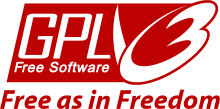This article may require copy editing for grammar, style, cohesion, tone, or spelling. (November 2023) |
 | |
| Author | Richard Stallman |
|---|---|
| Latest version | 3 |
| Publisher | Free Software Foundation |
| Published | 29 February 1989 |
| SPDX identifier |
|
| Debian FSG compatible | Yes[1] |
| FSF approved | Yes[2] |
| OSI approved | Yes (applies to GPLv3-only and GPLv2-only)[3] |
| Copyleft | Yes[2][4][5] |
| Linking from code with a different licence | Software licensed under GPL compatible licenses only, with the exception of the LGPL which allows all programs.[6] |
| Website | www |
The GNU General Public Licenses (GNU GPL or simply GPL) are a series of widely used free software licenses, or copyleft licenses, that guarantee end users the freedoms to run, study, share, and modify the software.[7] The GPL was the first copyleft license for general use. It was originally written by Richard Stallman, the founder of the Free Software Foundation (FSF), for the GNU Project. The license grants the recipients of a computer program the rights of the Free Software Definition.[8] The licenses in the GPL series are all copyleft licenses, which means that any derivative work must be distributed under the same or equivalent license terms. It is more restrictive than the Lesser General Public License and even further distinct from the more widely-used permissive software licenses such as BSD, MIT, and Apache.
Historically, the GPL license family has been one of the most popular software licenses in the free and open-source software (FOSS) domain.[7][9][10][11][12] Prominent free software programs licensed under the GPL include the Linux kernel and the GNU Compiler Collection (GCC). David A. Wheeler argues that the copyleft provided by the GPL was crucial to the success of Linux-based systems, giving the programmers who contributed to the kernel assurance that their work would benefit the whole world and remain free, rather than being exploited by software companies that would not have to give anything back to the community.[13]
In 2007, the third version of the license (GPLv3) was released to address some perceived problems with the second version (GPLv2) which were discovered during the latter's long-time usage.
To keep the license current, the GPL license includes an optional "any later version" clause, allowing users to choose between the original terms or the terms in new versions as updated by the FSF. Software projects licensed with the optional "or later" clause include the GNU Project, while projects like the Linux kernel is licensed under GPLv2 only.
The "or any later version" clause is sometimes known as a "lifeboat clause" since it allows combinations between different versions of GPL-licensed software to maintain compatibility.
- ^ "License information". The Debian Project. Software in the Public Interest (published 12 July 2017). 1997–2017. Archived from the original on 20 July 2017. Retrieved 20 July 2017.
... This page presents the opinion of some debian-legal contributors on how certain licenses follow the Debian Free Software Guidelines (DFSG). ... Licenses currently found in Debian main include:
- ...
- Expat/MIT-style licenses
- ...
- ^ a b "Various Licenses and Comments about Them". The GNU Project. Free Software Foundation (published 4 April 2017). 2014–2017. GNU General Public License (GPL) version 3. Archived from the original on 20 July 2017. Retrieved 20 July 2017.
... This is the latest version of the GNU GPL: a free software license, and a copyleft license. ... GPLv3 is not compatible with GPLv2 by itself. However, most software released under GPLv2 allows you to use the terms of later versions of the GPL as well. When this is the case, you can use the code under GPLv3 to make the desired combination. ...
- ^ "Licenses by Name". Open Source Initiative. n.d. Archived from the original on 20 July 2017. Retrieved 20 July 2017.
... The following licenses have been approved by the OSI. ...
- GNU General Public License version 2 (GPL-2.0)
- GNU General Public License version 3 (GPL-3.0)
- ...
- ^ "Various Licenses and Comments about Them". The GNU Project. Free Software Foundation (published 4 April 2017). 2014–2017. GNU General Public License (GPL) version 2. Archived from the original on 20 July 2017. Retrieved 20 July 2017.
... This is the previous version of the GNU GPL: a free software license, and a copyleft license. ... GPLv2 is, by itself, not compatible with GPLv3. However, most software released under GPLv2 allows you to use the terms of later versions of the GPL as well. When this is the case, you can use the code under GPLv3 to make the desired combination. ...
- ^ "Copyleft: Pragmatic Idealism – Free Software Foundation". Free Software Foundation. Retrieved 10 December 2009.
- ^ "GPL FAQ: If a library is released under the GPL (not the LGPL)". GNU Project. Free Software Foundation.
- ^ a b Cite error: The named reference
Black Duck Software-2015was invoked but never defined (see the help page). - ^ "GPL FAQ: Does using the GPL for a program make it GNU Software?". GNU Project. Free Software Foundation.
- ^ Cite error: The named reference
David A. Wheelerwas invoked but never defined (see the help page). - ^ Cite error: The named reference
freecode2008was invoked but never defined (see the help page). - ^ Cite error: The named reference
Asay-2009was invoked but never defined (see the help page). - ^ Cite error: The named reference
License proliferationwas invoked but never defined (see the help page). - ^ "Why the GPL rocketed Linux to success". Archived from the original on 16 May 2013. Retrieved 22 September 2006.
So while the BSDs have lost energy every time a company gets involved, the GPL'ed programs gain every time a company gets involved.